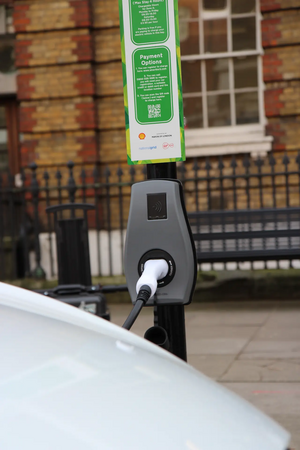The EV revolution hasn't happened yet, but why not?


https://www.facebook.com/greenlibdems/posts/3914133195271208With climate change now firmly on the agenda of most governments, bold activists like Gretta Thunberg increasingly shaming world leaders for their inaction on environmental matters and, over 4m people dying each year due to air quality issues around the world (World Health Organisation statistics), the driver for a greener, cleaner world and a transition from combustion engine to electric vehicles is pretty clear.
As a result, governments around the world (the UK included) have set ambitious dates by which they commit to meeting Net Zero emissions targets, all with the aim of limiting global warming to a maximum of 2 degrees above pre industrial levels. Key to meeting these commitments is the replacement of Internal Combustion Engine (ICE) vehicles with Electric Vehicles (EVs).
The auto industry - after both disruption by Tesla and the VW emissions scandal - has made and will continue to make huge investments in EV technology - $300bn planned by the end of 2020 (Forbes). Innovation and investments like these mean that EVs are already more efficient than ICE vehicles to run and will soon (2020/2021) be the same as or cheaper to buy.
However, despite these positive political steps and a step change in EV technology, adoption of EVs has not yet really accelerated and barriers still exist to a wholesale switch. Whilst most attention to date has focused on Range Anxiety and Cost, both issues are falling away as battery capacity increases, driving behaviours are better understood (the average journey in the UK is under 30km and in cities like London, less than 5km) and economies of scale grow. Instead, now the most critical issues (when speaking to those looking to buy vehicles) are the lack of sufficient or reliable charging Infrastructure and limited knowledge / understanding of the market.
Access to Infrastructure - To date, EVs have largely been adopted by the wealthy. This is a trend that has historically been driven by the high cost of EVs on the market, but continues now because of a lack of appropriate on street residential charging facilities. Over 80% of EV charging takes place at home, where it's most convenient and where, for large portions of time, the car sits unused. However, more than 45% of the UK population doesn't have off street parking (or the ability to install a home charger) and for these, largely urban dwelling people, the attractiveness and convenience of EV ownership is significantly reduced.
In cities where air quality issues and the need for EVs is most apparent, the link between wealth and access to off street parking is clear and yet, investment into on street residential and long stay charging has, to date been largely overlooked, in favour of destination, fast charging.
As a result, there is now increasing pressure on local authorities and landowners to install a more appropriate blend of charging infrastructure; one which provides convenient affordable charging for all and that gives users the confidence that they will be able to find suitable charging facilities at home and on the move.
Building and Activating the Charging Network
Those responsible for providing the public with EV charging infrastructure face a complex problem - assessing which is the most appropriate EV charging blend to support a wholesale societal switch, acting quickly enough to support adoption targets and importantly, to better engage and educate the population beyond early adopters.
As the government (both national and local), landowners and businesses set out to develop EV charging networks, it's important they give consideration to the following 5 key themes:
1. Network Convenience & Confidence - A lack of user confidence in, or convenient access to, existing UK charging infrastructure is now a key barrier to adoption of EV; particularly for those who don't have access to off-street parking. Government (national and local) must put pressure on Electric Vehicle Charging Point (EVCP) operators to increase the uptime of their assets, but also consider investing to support the deployment of EVCPs in far greater numbers, so that users can have the confidence that EVCPs will be available when and where they need it.
2. EV as an enabler for Smart Cities - EVs are a fundamental component of almost all smart cities plans/agendas, but rarely if ever is the smart cities agenda a component of EVCP operating networks or planned deployments. This is a huge missed opportunity, for network operators, city authorities and ultimately for the people living and working in urban areas, who could all see greater benefits and reduced costs (as well as disruption), where technology infrastructure deployment is paired.
3. Focus on Environmental Impact - Rising awareness of the importance of environmental issues means that there is growing pressure on the EV industry to deliver on the potential its technology offers, whilst also minimising the adverse impact (on people and the environment) of the deployment of charging infrastructure.
4. Speed of Technological Development - Charging and automotive technologies are developing fast and there is a need for those investing into charging technology to do more to ensure that infrastructure deployed now remains fit for purpose as technology advances. Without more informed planning and consideration of likely future requirements, the risk of not future-proofing charging infrastructure is twofold; not only that precious public and private investment funds are wasted, but also that in future, we find ourselves in the same position as today, where we have insufficient/incapable infrastructure to support the adoption of new mobility technologies.
5. Engagement and Education - EV technologies have advanced hugely in the past decade, with a current range of vehicles that matches or surpasses their ICE equivalents and newer, better models arriving all the time - about 350 new models will be on the market by 2022. Despite this, common misconceptions and (largely unfounded) anxieties about EV ownership still exist, not because the technology is lacking, but rather because the most critical component of the revolution, the consumer/the driver, has been forgotten. Effective engagement and education programmes have been shown to increase EV adoption rates in target areas and these should now be a core component of every infrastructure deployment.
Chris Pateman-Jones


Please join our Facebook Discussion of this article
From GLD Challenge Magazine 2019-20